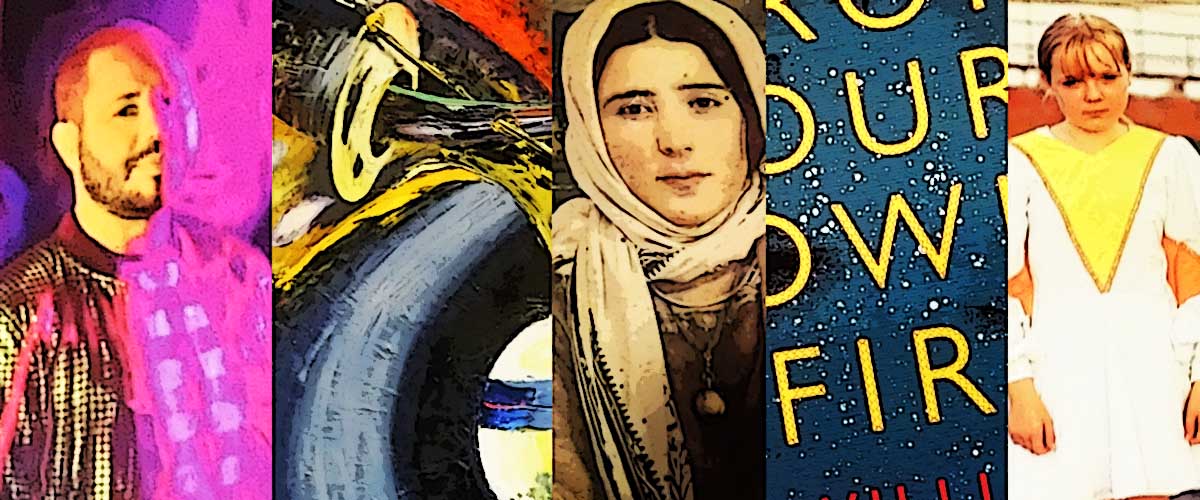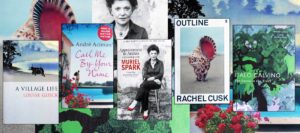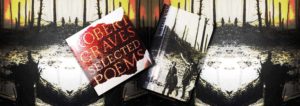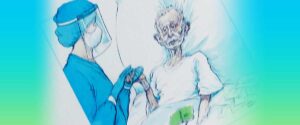You may be used to reading fiction or, say, biography. Books where you start at the beginning and follow the story through to the end. You may be used to reading factual texts where you can dot in and out, read pages or chapters a bit as you choose, looking for the nuggets of information you need.
If you’re not used to reading poetry, then it can seem a bit daunting, because you can’t really use either of these strategies.
At least, I can’t.
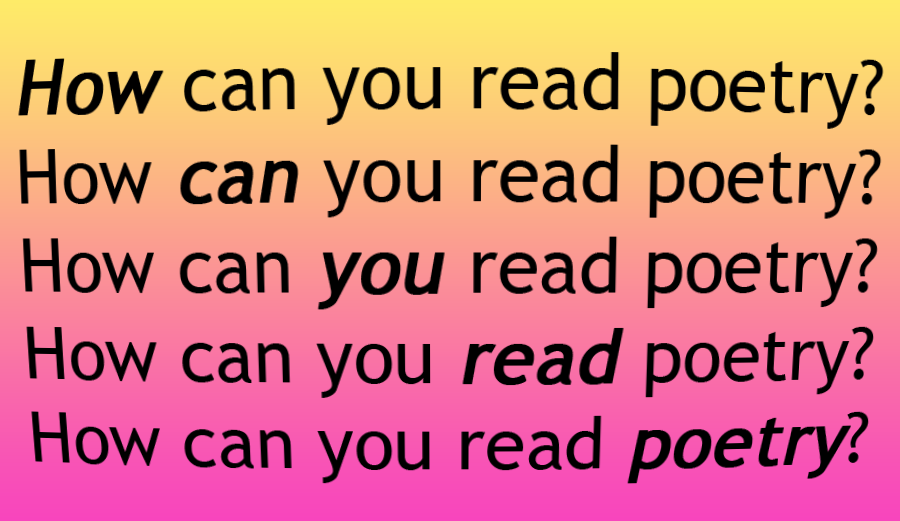
How can you read poetry?
I used to read poetry in anthologies. I still do. Big fat books, many of them: the Oxford Book of English Verse, the Norton Anthology of Poetry, or the collection Seamus Heaney and Ted Hughes made, The Rattle Bag. (My paperback edition, bought in the 1980s, is falling apart now.) Or I read selections and collections of the works of individual poets: Robert Graves Selected Poems, The Poems of John Keats.
These are titles on my bookshelves and I still dip into them from time to time. (So that reading strategy is the same as when I read factual texts.) But until 2021 I had rarely bought or picked up a book of poetry by a modern writer to read. Not since Seamus Heaney’s translation of Beowulf at the turn of the century. (That’s the one I remember off the top of my head.)
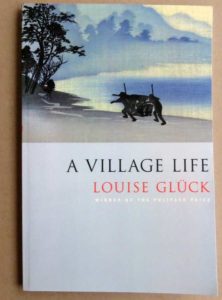
What changed was reading A Village Life by Louise Glück. I’d made a resolution (which still holds) to read a book or books by the current Nobel Literature laureate. When Glück received the prize, I knew nothing about her or her poetry, but I found this title in one of my local book shops.
I thought it was a hard read. Not for the poems so much as because I didn’t have a reading strategy. I’ve written in a previous post about how I eventually schooled myself to read it and was rewarded. But I didn’t find it easy.
How can you read poetry?
I described my reading strategy then like this:
I start each day with a new poem, or two poems if they are short, reading them slowly. Then I flip back through the book two or three pages at a time to re-read the poems that turn up. I finish off by re-reading the newest poem or poems again.
My current strategy is a development from this. Now I read a few poems, between two and six depending on length. I read each one twice at least and I read them aloud if possible.
The first time I open a book, that’s all I do.
On subsequent days, after I’ve read a handful of new poems, I’ll look back again at the earlier poems and re-read a few. I try to make the choice of poems to re-read random. So, maybe I’ll start from the first poem in the book and count forward two pages, or three poems, and go on from there till I come up to date. The re-reads I will usually only read once each sitting.
I continue doing this, sipping a few new poems and savouring them. Re-reading earlier ones. Once I get into the book, I start to develop favourites that I might pick out to re-read. Or I can deliberately pick poems I didn’t like so much to re-read, looking to find something new in them now.
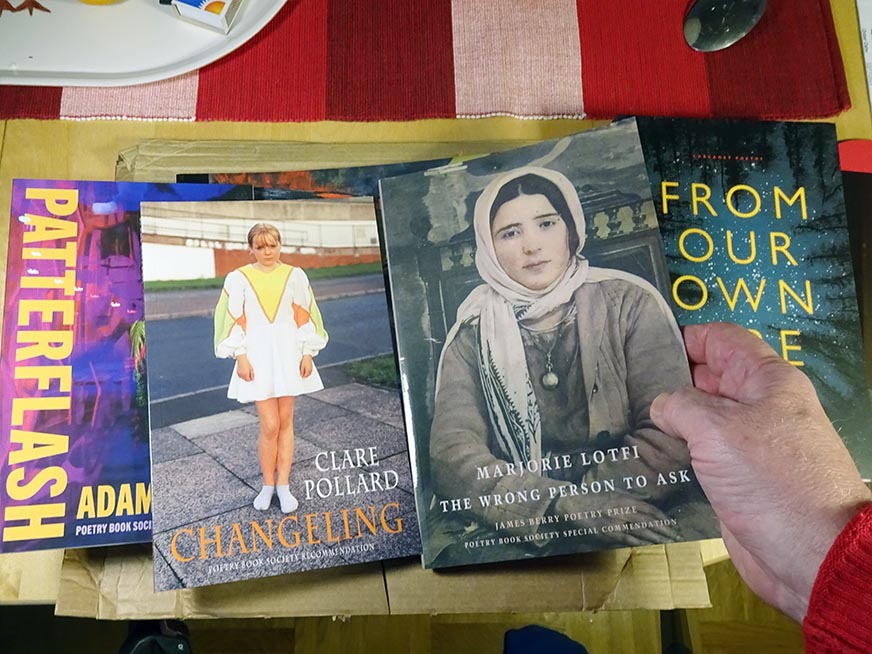
How can you read poetry?
I know how much work poets put into their poems. Reading this way, I feel I’m giving each poem the attention it deserves. I also found myself thinking – which I’ve not done before – about the effort that must have gone into structuring and ordering the collections.
I have the feeling that poems are like songs in an album. Sometimes a collection is just a series of poems, conveniently strung together. Other times they form a concept. (Thinking Please, Please Me contra Sgt. Pepper’s Lonely Hearts Club Band.)
At the end of 2023 I put in an order for a close-of-the-year bonanza. Seven titles by seven modern poets. I’d whittled the list down from twenty-two titles gleaned from various sources as the best of 2023, and altered it by considerations such as the availability of the titles from Kenny’s bookshop in Ireland. (I ended up ordering some older titles by the same poets because the newer ones weren’t in Kenny’s stock.)
I thought I would read all of them over the holidays. Using variations on my reading strategy, that didn’t happen. Instead I’ve been reading them bit by bit, interspersed with other books, over the months since. I’ve averaged one book of poetry each month and still have two titles to go.
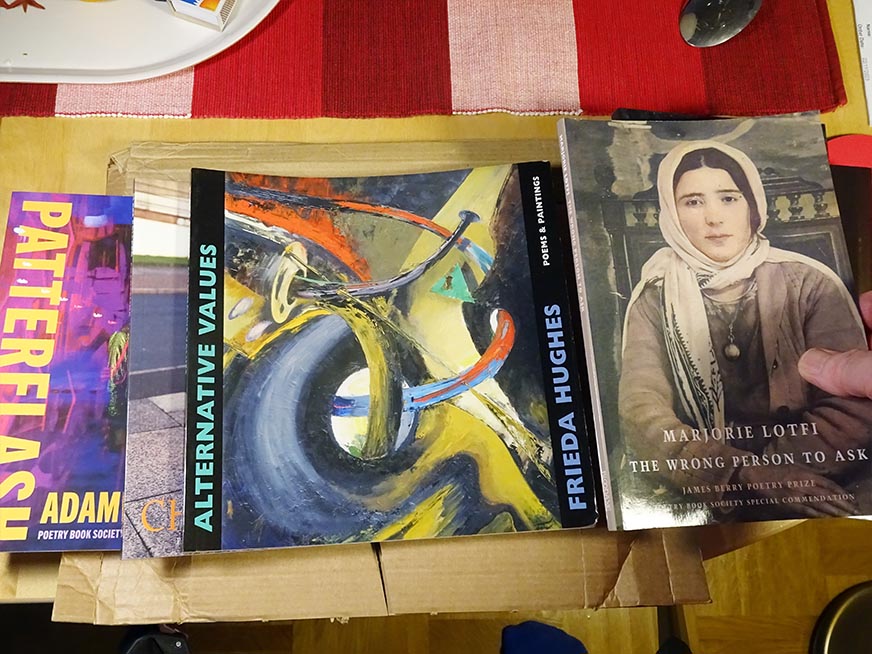
How can you read poetry?
My reading strategy is not conducive to speed, and I discovered I had to adjust it for some of the titles.
In the order in which I read them, the books are: Changeling by Clare Pollard; Alternative Values by Frieda Hughes; From Our Own Fire byWilliam Letford; The Wrong Person To Ask by Marjorie Lotfi; and Patterflash by Adam Lowe. (I’m currently reading Will You Walk a Little Faster by Penelope Shuttle and I have The Dog of Memory by Helen Farrish lined up next.)
Clare Pollard’s poems about changing states, drawing from current news, folk songs and mythology, fit my reading strategy very well. So did Marjorie Lotfi’s reports from the refugee experience. But William Letford’s poems from a near-future apocalyptic world alternate with flash-fiction/journal entries by Joe, his fictional poet. That called for a reassessment of how I might read them.
Freida Hughes pairs each of her poems with one of her abstract paintings, so the two work in symbiosis with one another. Again, I needed to find another reading – and viewing – strategy.
Most of Adam Lowe’s poems were amenable to the original strategy, but not all. Some of his poems about the experience of being queer and mixed race in northern England he writes in dialect. Others use Polari, the showman’s cant particularly associated with Britain’s gay subculture. (Lowe kindly includes a glossary.) For me reading these poems is a bit like reading in a foreign language with a dictionary at my elbow.
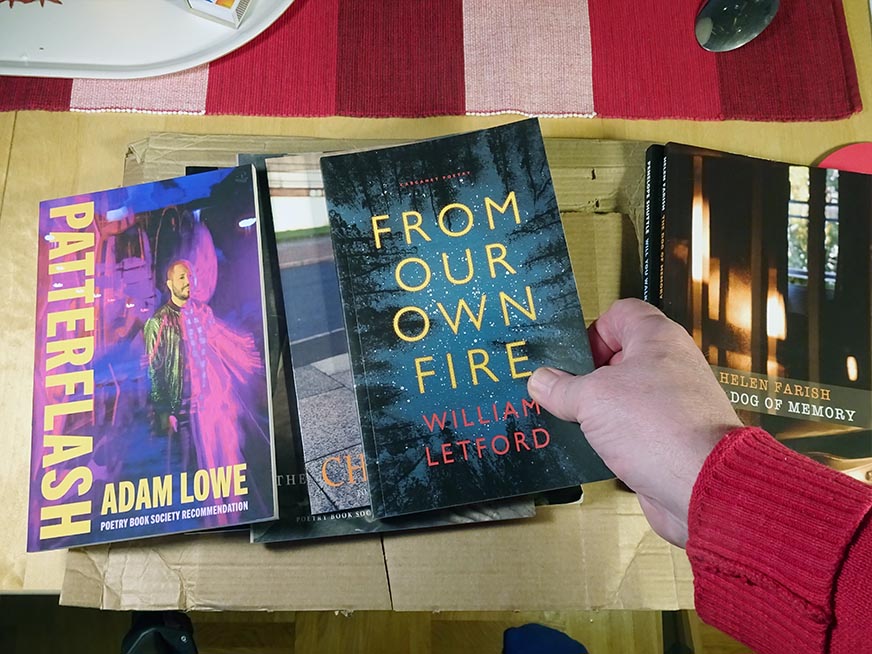
How can you read poetry?
One problem with my poetry reading strategy that I haven’t yet solved is this: I get to the end of the book and “know” the earlier poems well, but I haven’t given nearly as much attention to the later poems. How to give the later poems an equal chance?
I’ve tried starting the book over again, reading the first few poems and flipping back to randomly read the later ones. I’ve tried re-reading the whole book at one sitting. (That doesn’t work for me.) I’ve tried working backwards from the end. But nothing seems satisfactory.
How do you, how would you, bring reading a book of poetry to a satisfactory conclusion?
Writing a blog post about reading poetry by reference to these recent titles has been fun, though. I’ve been looking back at my reading notes and dipping into the books again. Re-reading some of my favourites. I recommend it!

